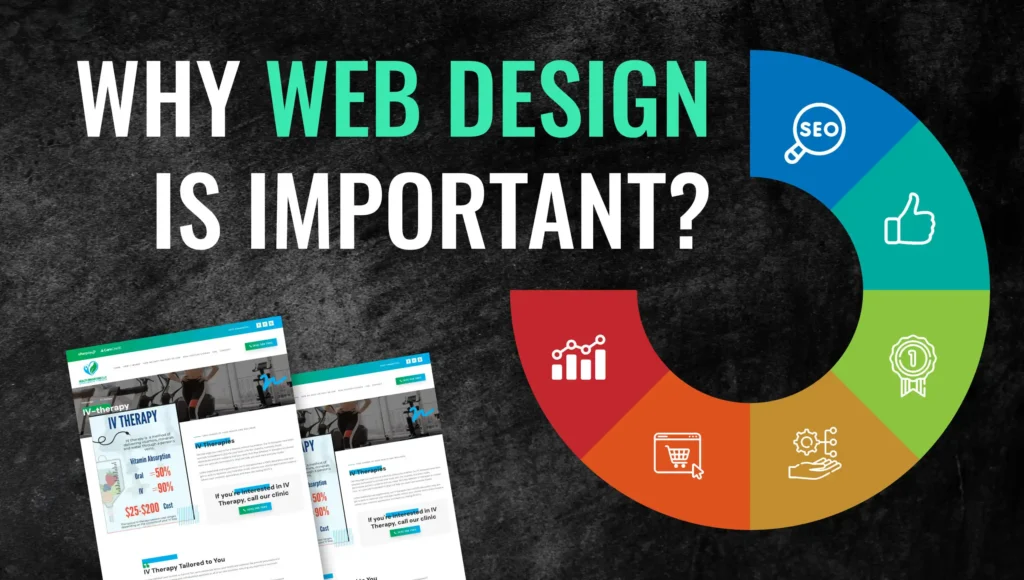Why Web Design is Important: The Key to Building a Strong Online Presence
In today’s digital world, having a website isn’t enough. Your website must be functional, aesthetically pleasing, and optimized for user experience. Why web design is important isn’t just about making your website look good; it’s about how it works, interacts with users, and achieves business goals. As a seasoned professional in web design, I’ve seen firsthand how critical it is for businesses to prioritize web design in their digital strategy. This blog post will explore why web design is important and how it can make or break your online success.
What is Web design?
Before we discuss why web design is important, it’s essential to clarify what it involves. Website design is the process of creating and organizing a website’s visual elements, layout, and functionality. This includes selecting fonts, colors, images, and graphics and ensuring the site is easy to navigate, mobile-friendly, and optimized for search engines.
Web design is about creating a seamless, user-friendly experience that allows visitors to interact with the website efficiently and intuitively. When done correctly, web design encourages users to stay longer, engage with your content, and ultimately take action, such as purchasing, signing up for a newsletter, or contacting your business.
Key Components of Web Design:
- Layout: The structure and arrangement of content on the page.
- Typography: The fonts and text styles used to enhance readability.
- Color Scheme: The palette of colors that define the website’s look.
- Graphics and Images: Visual elements that enhance the aesthetics and user experience.
- User Interface (UI): The interactive aspects of the site, such as buttons, menus, and forms.
When people ask what is web designing, it’s essentially the art and science of blending all these components into a cohesive and functional website.
What is Website Design?
Website design refers to planning, creating, and arranging a website’s visual and functional aspects. This includes layout, color schemes, fonts, graphics, and the site’s overall structure. The goal of website design is to make a site look appealing and ensure a seamless, user-friendly experience.
A good website design combines aesthetics with functionality, ensuring the website is easy to navigate, responsive (works well on mobile devices), and aligned with the business’s goals. It also involves optimizing the site for fast load times and meeting the needs of both users and search engines.
In short, website design is pivotal in creating a positive first impression, building trust with visitors, and encouraging actions such as purchasing, filling out a contact form, or engaging with content.
Why Web Design is Important: The First Impressions Matter
The first impression users get from your website can significantly influence their decision to stay or leave. Visitors will likely leave within a few seconds if your website is slow to load, difficult to navigate, or visually outdated. This is why web design is important—it can distinguish between a visitor becoming a customer or bouncing to a competitor’s site.
Case Study: E-Commerce Website Redesign
I had the opportunity to work with an e-commerce company experiencing a high bounce rate on their website. The company had a great product, but its website was dated, slow to load, and challenging for users to navigate. We focused on redesigning the site with a clean, modern aesthetic, improving the site speed, and ensuring that product pages were easy to browse. The result was a 40% increase in user engagement and a 25% increase in sales within the first three months of the launch.
This experience demonstrates how impactful web design can be. The right design can improve user experience and directly affect business outcomes.
Why Website Design is Important
Website design is important because it directly impacts a site’s user experience, credibility, and performance. A well-designed website creates a positive first impression, helping to build trust with visitors and keep them engaged longer. Here are a few reasons why website design is important:
Why is the Design of a Website Important for User Experience?
User experience (UX) is one of the most critical factors that affect how visitors perceive and interact with your website. When well executed, web design leads to an enjoyable and frictionless user experience, likely increasing conversions and boosting customer satisfaction.
Navigation and Usability
The structure and layout of your website should make it easy for visitors to find what they are looking for. Intuitive navigation is key, whether it’s a product, contact information, or a blog post. Why is web design important for usability? A poorly structured site will frustrate users, which could lead them to abandon the site in favor of a competitor. Ensuring your website’s navigation is simple and intuitive is a major factor in improving user experience.
In one project, I worked with a client in the healthcare industry with a website that users found hard to navigate. We reorganized the website’s structure, placing essential information such as appointment scheduling and contact details where they were easy to access. We also ensured the site was responsive and adapted seamlessly across different devices. As a result, the client’s user satisfaction rate improved, and they reported a 15% increase in patient inquiries.
Mobile Responsiveness
With mobile internet usage surpassing desktop usage, having a website that works well on mobile devices is no longer optional. Why is web design important in the context of mobile optimization? A website that isn’t mobile-friendly will frustrate users and be penalized by search engines like Google. Mobile optimization ensures that your website displays correctly across all devices and provides a smooth experience, no matter where or how users access it.
I redesigned a local restaurant’s website for another project to be fully mobile-optimized. The old site was not responsive, and users had difficulty reading menus or making phone reservations. After we revamped the design with mobile-first principles, the restaurant saw a 20% increase in online reservations from mobile users.
Why Website Design is Important for Search Engine Optimization (SEO)
One key aspect of web design that many overlook is its impact on SEO. Search engine optimization (SEO) is about optimizing your website to rank higher in search engine results pages (SERPs). Proper web design can significantly improve your SEO efforts by ensuring your website is structured correctly for search engines to crawl and index it efficiently.
For example, a recent e-commerce project I worked on had a beautiful design, but the site wasn’t optimized for search engines. Its organic traffic doubled within a few months after the website was redesigned to ensure it was faster, mobile-friendly, and search-engine-optimized. This was a direct result of a more effective website design that improved user experience and SEO.
Page Speed and SEO
Page load speed is a crucial factor in both user experience and SEO. Slow-loading websites not only frustrate users but also rank lower on search engines. Google and other search engines prioritize websites that load quickly, so optimizing your site’s performance is essential for user satisfaction and search rankings.
For a recent project, we worked with a retail client facing challenges with slow page speeds. After optimizing images, using content delivery networks (CDNs), and implementing better caching strategies, the site’s load time decreased by 50%, leading to improved rankings and better user engagement.
Mobile-First Indexing
Google now uses mobile-first indexing, which means it considers the mobile version of your website the primary source for ranking and indexing. This makes web design even more important because you could lose valuable search engine rankings if your mobile site isn’t optimized.
Ensuring your website is mobile-friendly and responsive is crucial for maintaining strong SEO performance. This is especially true now that more users access websites from mobile devices than ever.
Building Trust and Credibility Through Web Design
Your website is often the first point of contact potential customers have with your business. This means that the design of your site directly impacts how trustworthy and credible your business appears. A poorly designed site can give the impression that your business is outdated or unreliable, whereas a modern, professional website can help establish trust with visitors.
Case Study: Law Firm Website Redesign
I worked with a law firm that needed a website redesign to reflect its expertise and professionalism. The old site was cluttered and outdated and didn’t effectively showcase the firm’s services. After the redesign, which included modern aesthetics, clear CTAs, and client testimonials, the firm saw a significant increase in client inquiries, as potential clients felt more confident in the firm’s services.
This case illustrates how web design can influence how users perceive your business. A well-designed site looks better and can help establish credibility and trust, which is crucial in industries requiring high professionalism, like law and healthcare.
Conversion Optimization: How Web Design Affects Sales
The ultimate goal of any website is to drive conversions. Whether making a sale, capturing a lead, or encouraging users to take another action, web design is crucial in optimizing conversion rates.
Strategic Call-to-Actions (CTAs)
An effective web design incorporates strategically placed calls to action (CTAs) that guide users toward taking the desired steps. These CTAs should be easy to find, clear in their messaging, and compelling enough to encourage users to act.
For example, I worked on an e-commerce site where we optimized the placement of CTAs and simplified the checkout process. As a result, the site saw a 35% increase in completed transactions in just a few weeks. This demonstrates how a well-designed website can significantly improve conversion rates.
Simplified Forms and Checkout Processes
Another key factor in conversion optimization is simplifying the process for users. Whether it’s a contact form, newsletter signup, or checkout process, users are less likely to complete a conversion if it is too complicated or lengthy. A streamlined, user-friendly form or checkout process can increase conversions by reducing friction and making it easy for users to take action.
Conclusion: Why Web Design is a Crucial Part of Your Online Strategy
To summarize, web design is important because it influences nearly every aspect of your website’s performance, from user experience to SEO to conversion rates. A well-designed website can increase engagement, build trust with your audience, improve your search rankings, and drive business growth.
As my experience shows, businesses that invest in professional web design see higher user satisfaction, improved SEO performance, and, ultimately, more conversions. Whether you want to redesign your current site or launch a new one, understanding why web design is important and incorporating best practices will ensure your website works for you.
FAQ
Why is website design important?
Website design is crucial because it affects user experience, accessibility, and conversion rates. A well-designed website helps build trust with visitors, improves navigation, and ensures your site performs well across all devices, ultimately leading to higher engagement and better business results.
What is the main purpose of a web designer?
The main purpose of a web designer is to create visually appealing, user-friendly websites that meet the business’s and its visitors’ needs. Web designers ensure the site is functional, easy to navigate, and aligned with the brand’s goals.
What is the main goal of web design?
The main goal of web design is to provide a seamless, engaging, and intuitive user experience. This includes creating a website that’s visually appealing, easy to navigate, mobile responsive, and optimized for performance while aligning with the business’s objectives.
Is web design an important skill?
Web design is an important skill because it combines creativity with technical expertise. A solid understanding of design principles, user experience, and web development is crucial for creating functional, aesthetically pleasing websites optimized for both users and search engines.
Why did you choose web design?
I chose web design because it’s a dynamic field that allows me to combine creativity with technology. Designing websites that help businesses grow and provide users with valuable, enjoyable experiences is incredibly rewarding. It’s a blend of art and function that makes a real impact on both the digital world and the bottom line.


